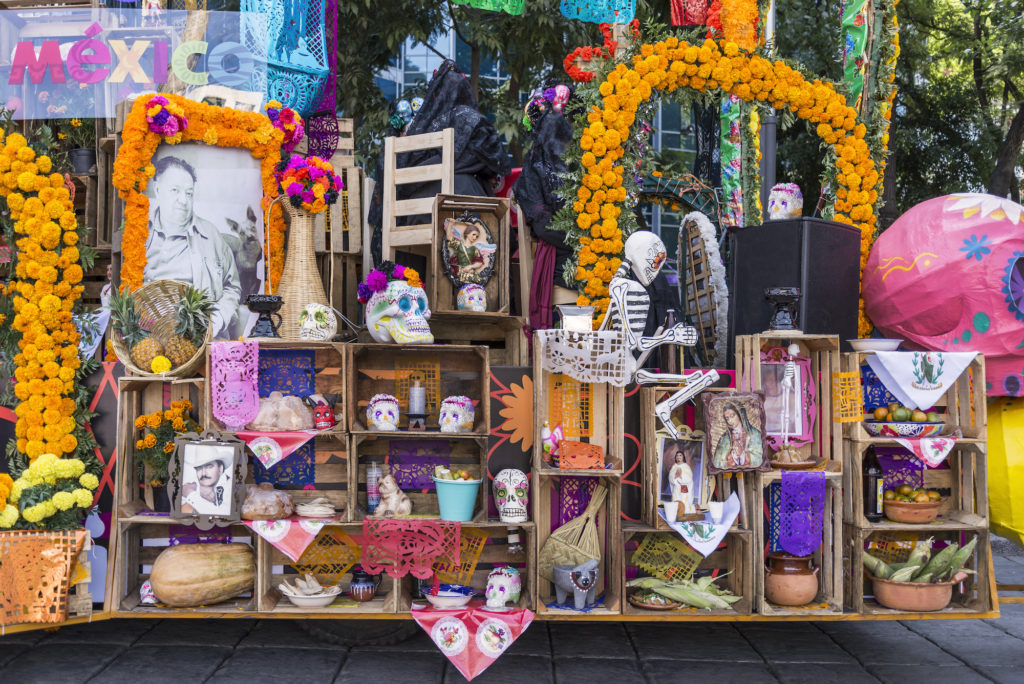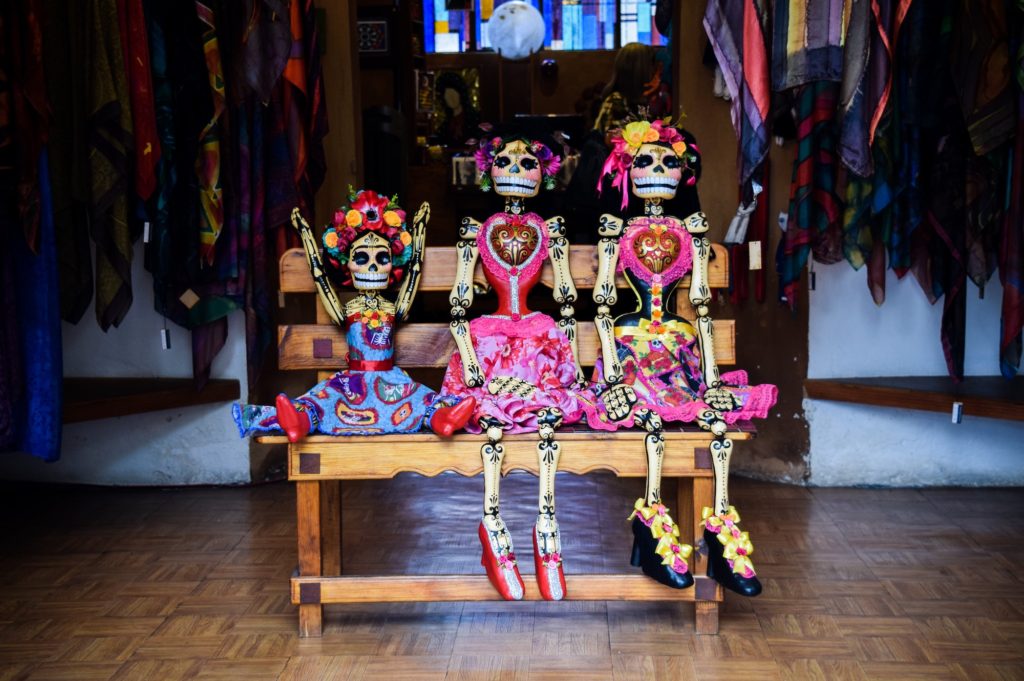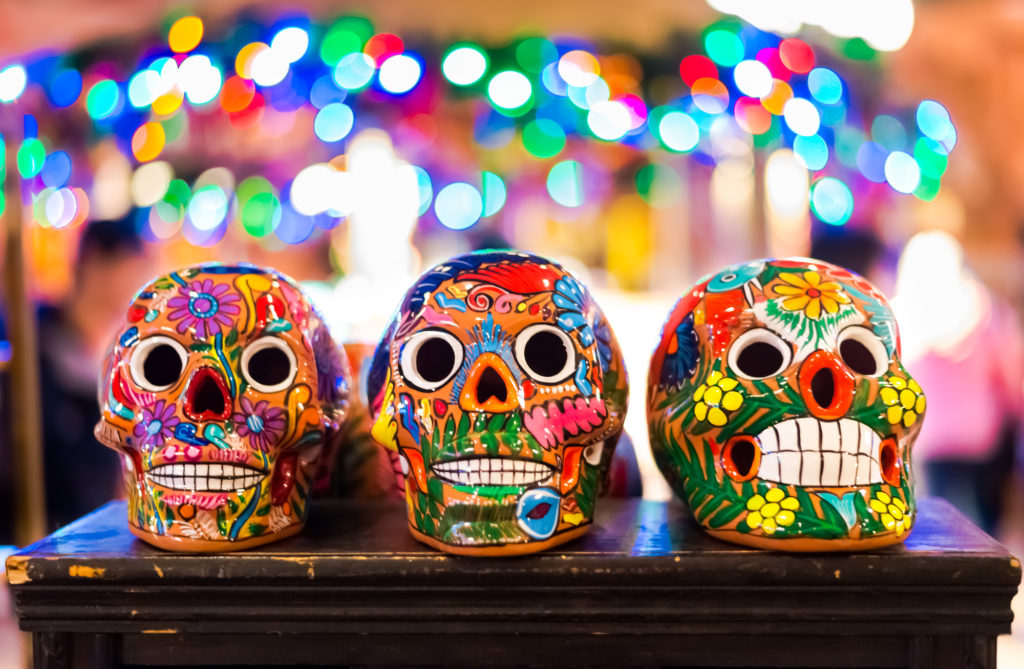“El culto a la vida, si de verdad es profundo y total, es también culto a la muerte. Ambas son inseparables. Una civilización que niega a la muerte acaba por negar a la vida.”
— Octavio Paz, “Todos Santos, Día de Muertos”, El laberinto de la soledad, 1950.
Now that Halloween is right around the corner, I’m betting we’re going to see at least one person dressed up as a sugar skull, the Mexican inspired face makeup that transforms any fleshy face into a colorfully decorated skull.
They’ve been popular for years and I can only assume they’re even more popular now after the massive success of Pixar’s “Coco,” a film about a young boy who ventures into the Land of the Dead on Día de Los Muertos.
According to the movie, on the Day of the Dead, a bridge of cempasúchitl (Mexican marigold) unites the Land of the Living with that of the Dead so the dead can visit their loved ones for just that one day. But there’s a catch: in order to cross the bridge, a family member must display a picture of the dead one in an altar made for the occasion called ofrenda.
The movie doesn’t veer off too much from reality.
The Día de Los Muertos is celebrated as a national holiday in Mexico on November 1 and 2. The first is a day to remember departed children and the second is for the departed adults.
Often associated with Halloween, the Day of the Dead takes a different look at death by not mourning it or shrouding it in sadness, but rather celebrating and remembering the deceased’s life.
Families in Mexico, where it is most popular, visit cemeteries and decorate tombstones with flowers, especially cempasúchitl. They drink and eat by their side and tell stories of the person’s life.
At home, altars of all sizes are set up with things they enjoyed, like food, drinks, musical records, and even alcohol or cigarettes. Altars may also include a sweet bread called “Pan de Muerto” and sugar skulls, all decorated with china paper cut into patterns called “papel picado” and more cempasúchitl.
Origins

The Day of the Dead is a mix between two worlds: The native Aztecs of modern-day Mexico and the Spanish who colonized them.
In contrast to their Spanish conquistadors, the Aztecs had a very different idea of what happened after death. While both groups assumed there would be life after death, to the Aztecs, being good or bad in life did not determine someone’s afterlife. Rather, it was the way someone died that determined how they would serve the gods.
The worst thing that could happen to an Aztec was to die of old age, or a natural death. These souls were destined a long tortuous journey of four years down the nine levels of Mictlán, the underworld.
During their descent, these souls had to cross a river full of blood and terrifying jaguars, resist skin-slashing winds with only the blanket they were buried with as protection, avoid being crushed between two colliding mountains and somehow survive a path full of heart-eating demons, among other perils.
After the four years, the souls were welcomed by Mictlantecuhtli, the Lord of Death and King of the Underworld, and his wife and queen, Mictecacihuatl, known in popular culture as “La Catrina,” and depicted as the skeleton of a woman with a fancy dress and oversized hat.
Together, Mictlantecuhtli and Mictecacihuatl ruled the underworld, guarded the bones of the dead and were a welcome sight to the souls who travelled the tortuous journey there. But while Mictlán was a relief from the hazardous journey, it wasn’t exactly rosy. It has been described as a dark and gloomy place with no windows or doors and from which there is no exit. Its ruler? Not exactly Queen Elizabeth.
Ernest L. Abel described the King of the Underworld in his “Death Gods: An Encyclopedia of the Rulers, Evil Spirits, and Geographies of the Dead”:
Mictlantecuhtli had an insatiable hunger for human flesh and blood. He was a blood-splattered, partially de-fleshed skeleton with a menacing grin who wore a headdress with owl feathers, a necklace of human eyeballs, a human bone for an earplug, and had claws for hands in which he carried a knife or axe to remove the hearts of those he claimed.
People who died more respected deaths had nicer fates. Warriors fallen in battle would accompany the Eastern wind to help the sun rise. Women who died during childbirth would go with the Western wind to help the sun set, while children would go to a place where a massive tree fed them milk from its branches so they could grow strong and repopulate the earth when the current race perished.
The Aztecs also believed that after some time the dead would return to the land of the living to visit, so they held a festival for the entire month of August to celebrate their arrival and to honor Mictecacihuatl.
With the arrival of the Spanish to Mexico and introduction of Catholicism, the Church sought to end any inkling of what they called paganism, as they had done often with other cultures and casually disguised the remnants for this month-long celebration as the Catholic celebration of All Saints and All Souls Day on November 2.
Slowly, as the indigenous ethos of the Aztecs effaced, it started merging with the imposed beliefs of the Church to create what is today the Day of the Dead. A mixture of a magical realism past with the stark piety of the Catholic Church.
Modern day

Because the festival for the dead was an indigenous tradition, the Day of the Dead was not observed throughout all of Mexico before it was declared a national holiday and taught in schools. Still, some more conservative families choose to celebrate the more puritan version of All Souls Day, but the exoticness of what is Day of the Dead in Mexico has propelled it as one of the most unique holidays in the world.
So much so that in 2008 the United Nations Educational, Scientific and Cultural Organization (UNESCO) added the Day of the Dead to their Representative List of the Intangible Cultural Heritage of Humanity.
Depicted in movies and shows, it’s hard to escape its existence, especially while living in the United States, where more than 36 million people are Mexican or of Mexican origin. In fact, the Day of the Dead is celebrated exquisitely in California in Los Angeles since the 1970s and Santa Ana since the 2000s with parades, marketplaces and public ofrendas. In Florida, Fort Lauderdale has one of the largest Day of the Dead celebrations in the state.
In Orlando, you can celebrate the day with a themed exhibit and block party with live performances, vendors and more at CityArts Orlando on October 17 from 7 p.m. to 11 p.m. The art exhibit will continue until November 15.
Wherever the Day of the Dead is celebrated, exorbitantly in Mexico or quietly in the home of an expat in Hamburg, Germany, the idea that remains is always the same: remembrance. The dead are not dead until they are forgotten, or so the saying goes.
This November 2, I invite you to light a candle for your departed loved ones. To remember them and tell tales of their lives to those young ones who did not know them. To lift a glass and drink to their memory, for it was thanks to them that you exist. We are nothing without our past. ¡Salud!
You may also like
-
J Balvin Deslumbra en Orlando en su gira “Back to the Rayo”
-
Orange County Government Announces Events Celebrating Asian American and Pacific Islander Heritage Month
-
CALENDARIO DE EVENTOS
-
Entendiendo el Atractivo de los Dramas de Narcotráfico como Colombiana Viendo “Griselda”
-
Reconciling the Allure of Drug Dramas as a Colombian watching “Griselda”
















